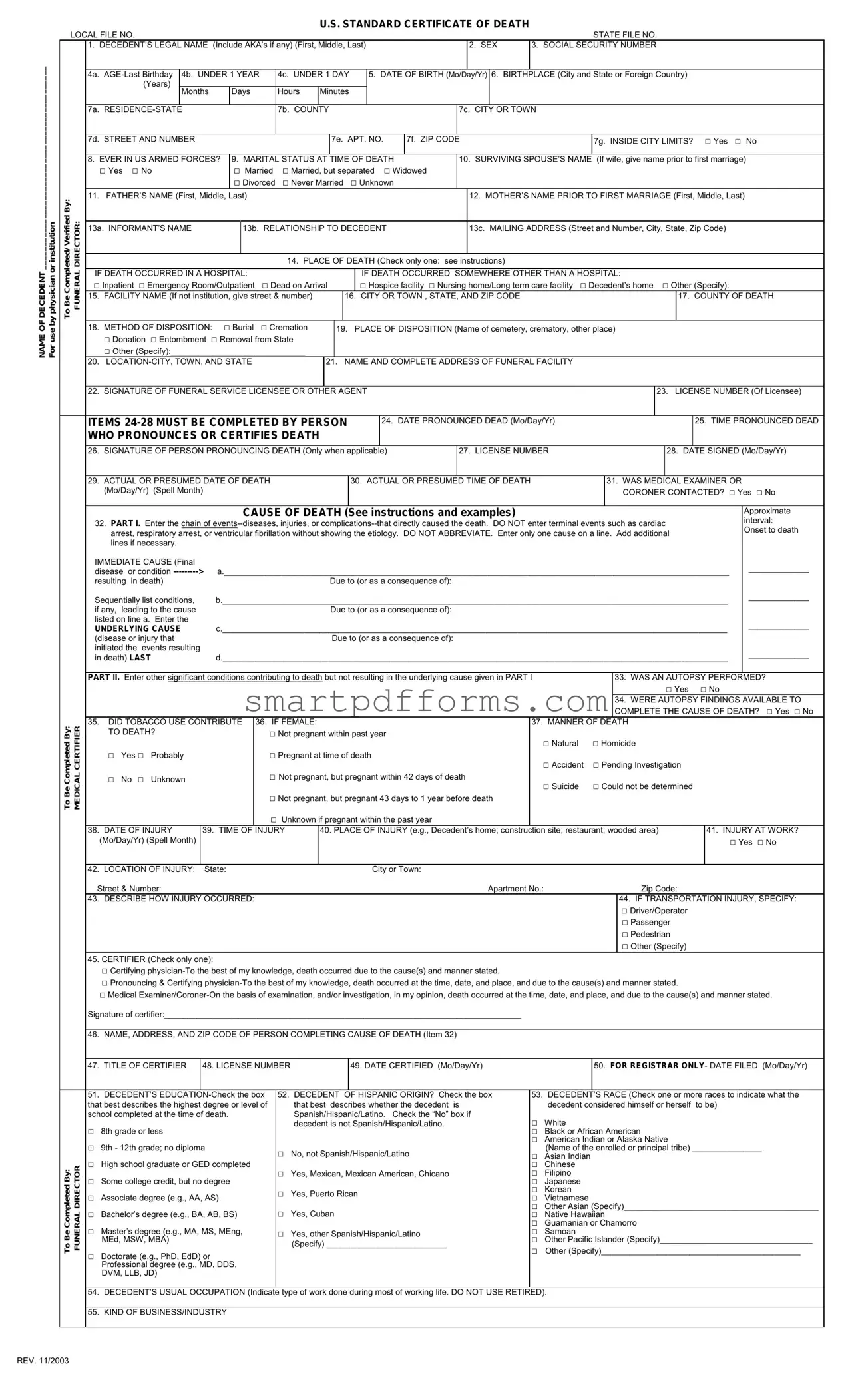MEDICAL CERTIFIER INSTRUCTIONS for selected items on U.S. Standard Certificate of Death
(See Physicians’ Handbook or Medical Examiner/Coroner Handbook on Death Registration for instructions on all items)
ITEMS ON WHEN DEATH OCCURRED
Items 24-25 and 29-31 should always be completed. If the facility uses a separate pronouncer or other person to indicate that death has taken place with another person more familiar with the case completing the remainder of the medical portion of the death certificate, the pronouncer completes Items 24-28. If a certifier completes Items 24-25 as well as items 29-49, Items 26-28 may be left blank.
ITEMS 24-25, 29-30 – DATE AND TIME OF DEATH
Spell out the name of the month. If the exact date of death is unknown, enter the approximate date. If the date cannot be approximated, enter the date the body is found and identify as date found. Date pronounced and actual date may be the same. Enter the exact hour and minutes according to a 24-hour clock; estimates may be provided with “Approx.” placed before the time.
ITEM 32 – CAUSE OF DEATH (See attached examples)
Take care to make the entry legible. Use a computer printer with high resolution, typewriter with good black ribbon and clean keys, or print legibly using permanent black ink in completing the CAUSE OF DEATH Section. Do not abbreviate conditions entered in section.
Part I (Chain of events leading directly to death)
•Only one cause should be entered on each line. Line (a) MUST ALWAYS have an entry. DO NOT leave blank. Additional lines may be added if necessary.
•If the condition on Line (a) resulted from an underlying condition, put the underlying condition on Line (b), and so on, until the full sequence is reported. ALWAYS enter the underlying cause of death on the lowest used line in Part I.
•For each cause indicate the best estimate of the interval between the presumed onset and the date of death. The terms “unknown” or “approximately” may be used. General terms, such as minutes, hours, or days, are acceptable, if necessary. DO NOT leave blank.
•The terminal event (for example, cardiac arrest or respiratory arrest) should not be used. If a mechanism of death seems most appropriate to you for line (a), then you must always list its cause(s) on the line(s) below it (for example, cardiac arrest due to coronary artery atherosclerosis or cardiac arrest due to blunt impact to chest).
• If an organ system failure such as congestive heart failure, hepatic failure, renal failure, or respiratory failure is listed as a cause of death, always report its etiology on the line(s) beneath it (for example, renal failure due to Type I diabetes mellitus).
•When indicating neoplasms as a cause of death, include the following: 1) primary site or that the primary site is unknown, 2) benign or malignant, 3) cell type or that the cell type is unknown, 4) grade of neoplasm, and 5) part or lobe of organ affected. (For example, a primary well- differentiated squamous cell carcinoma, lung, left upper lobe.)
•Always report the fatal injury (for example, stab wound of chest), the trauma (for example, transection of subclavian vein), and impairment of function (for example, air embolism).
PART II (Other significant conditions)
•Enter all diseases or conditions contributing to death that were not reported in the chain of events in Part I and that did not result in the underlying cause of death. See attached examples.
•If two or more possible sequences resulted in death, or if two conditions seem to have added together, report in Part I the one that, in your opinion, most directly caused death. Report in Part II the other conditions or diseases.
CHANGES TO CAUSE OF DEATH
Should additional medical information or autopsy findings become available that would change the cause of death originally reported, the original death certificate should be amended by the certifying physician by immediately reporting the revised cause of death to the State Vital Records Office.
ITEMS 33-34 - AUTOPSY
•33 - Enter “Yes” if either a partial or full autopsy was performed. Otherwise enter “No.”
•34 - Enter “Yes” if autopsy findings were available to complete the cause of death; otherwise enter “No”. Leave item blank if no autopsy was performed.
ITEM 35 - DID TOBACCO USE CONTRIBUTE TO DEATH?
Check “yes” if, in your opinion, the use of tobacco contributed to death. Tobacco use may contribute to deaths due to a wide variety of diseases; for example, tobacco use contributes to many deaths due to emphysema or lung cancer and some heart disease and cancers of the head and neck. Check “no” if, in your clinical judgment, tobacco use did not contribute to this particular death.
ITEM 36 - IF FEMALE, WAS DECEDENT PREGNANT AT TIME OF DEATH OR WITHIN PAST YEAR?
This information is important in determining pregnancy-related mortality.
ITEM 37 - MANNER OF DEATH
•Always check Manner of Death, which is important: 1) in determining accurate causes of death; 2) in processing insurance claims; and 3) in statistical studies of injuries and death.
•Indicate “Pending investigation” if the manner of death cannot be determined whether due to an accident, suicide, or homicide within the statutory time limit for filing the death certificate. This should be changed later to one of the other terms.
•Indicate “Could not be Determined” ONLY when it is impossible to determine the manner of death.
ITEMS 38-44 - ACCIDENT OR INJURY – to be filled out in all cases of deaths due to injury or poisoning.
•38 - Enter the exact month, day, and year of injury. Spell out the name of the month. DO NOT use a number for the month. (Remember, the date of injury may differ from the date of death.) Estimates may be provided with “Approx.” placed before the date.
•39 - Enter the exact hour and minutes of injury or use your best estimate. Use a 24-hour clock.
•40 - Enter the general place (such as restaurant, vacant lot, or home) where the injury occurred. DO NOT enter firm or organization names. (For example, enter “factory”, not “Standard Manufacturing, Inc.” )
•41 - Complete if anything other than natural disease is mentioned in Part I or Part II of the medical certification, including homicides, suicides, and accidents. This includes all motor vehicle deaths. The item must be completed for decedents ages 14 years or over and may be completed for those less than 14 years of age if warranted. Enter “Yes” if the injury occurred at work. Otherwise enter “No”. An injury may occur at work regardless of whether the injury occurred in the course of the decedent’s “usual” occupation. Examples of injury at work and injury not at work follow:
Injury at work |
Injury not at work |
Injury while working or in vocational training on job premises |
Injury while engaged in personal recreational activity on job premises |
Injury while on break or at lunch or in parking lot on job premises |
Injury while a visitor (not on official work business) to job premises |
Injury while working for pay or compensation, including at home |
Homemaker working at homemaking activities |
Injury while working as a volunteer law enforcement official etc. |
Student in school |
Injury while traveling on business, including to/from business contacts |
Working for self for no profit (mowing yard, repairing own roof, hobby) |
|
Commuting to or from work |
•42 - Enter the complete address where the injury occurred including zip code.
•43 - Enter a brief but specific and clear description of how the injury occurred. Explain the circumstances or cause of the injury. Specify type of gun or type of vehicle (e.g., car, bulldozer, train, etc.) when relevant to circumstances. Indicate if more than one vehicle involved; specify type of vehicle decedent was in.
•44 -Specify role of decedent (e.g. driver, passenger). Driver/operator and passenger should be designated for modes other than motor vehicles such as bicycles. Other applies to watercraft, aircraft, animal, or people attached to outside of vehicles (e.g. surfers).
Rationale: Motor vehicle accidents are a major cause of unintentional deaths; details will help determine effectiveness of current safety features and laws.
REFERENCES
For more information on how to complete the medical certification section of the death certificate, refer to tutorial at http://www.TheNAME.org and resources including instructions and handbooks available by request from NCHS, Room 7318, 3311 Toledo Road, Hyattsville, Maryland 20782- 2003 or at www.cdc.gov/nchs/about/major/dvs/handbk.htm



